At this stage of development I wasn’t planning on adding new mechanics, but projectile penetration has been hovering around on my to-do list ever since early playtesting showed the game would really benefit from a way to shoot through objects.
The ability to simultaneously hit an entire line of enemies, or even fire through obstructions to hit a target on the other side, really does add a lot of tactical depth. An additional mechanic also enables yet another category of weapons with meaningful variety (<--a key requirement when adding any “new stuff”). More on the new weapons below. Penetrating projectiles will also be a great addition for the Hunter class robots, which are so crazy aggressive they’ll start shooting as soon as they detect you, even while you’re behind a wall or on the opposite side of some obstruction. (You might remember them from the 7DRL if you got far enough.) Their combat AI type is literally named “INSANE” =p
Mechanics
Each weapon specifies a maximum number of obstructions its projectiles can penetrate, along with a separate chance to pass through each consecutive obstruction. For example the basic Coil Gun can penetrate up to two objects, the first at a 60% chance, and the second at a 30% chance. A third object after that would still take damage, but the projectile would stop there. If any chance fails along the way, the projectile does not continue beyond the point of impact, even if it destroys the object.
You don’t have to destroy something to penetrate it--the mechanic is completely independent of damage, meaning you can now even fire through walls to hit targets on the other side without taking down the wall itself. I’m sure players will find some creative ways to screw with the AI that I’ll have to address later… but it’s fun!
Weapons
A majority of projectiles cannot continue after striking their first target, and of the original item set only ballistic weapons of the slug-firing variety (e.g. Gauss Rifle) were given a chance to penetrate one or two obstructions. However, these are not a very reliable way to penetrate a target. At best you can hope to get lucky with them.
New variants of those ballistic weapons are designed specifically for penetration and thus much more reliable. They carry the “Hypervelocity” designation, and may penetrate up to three or four obstructions--meaning some can hit up to five targets!
Hypervelocity weapons exchange damage capability for penetrative potential, but make up for the lack of collateral damage with a greatly increased chance of a critical hit due to passing through an object.
In a related development, critical hits now destroy props, too (not just robot parts/cores), otherwise this new category of weapons could endlessly fire through machines to hit targets on the other side without ever scratching the machine itself, which looks weird and doesn’t make sense (props are normally destroyed only when a single damage application reaches an integrity threshold, making it impossible for weak weapons to chip away at a stronger obstacle to eventually destroy it).
Usage
The line-of-fire visualization for aiming got a little update since obstructions may not necessarily block a shot anymore. It will now assume maximum penetration for the given weapon(s) and highlight any penetration points in blue.
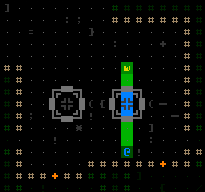
Aiming a Hypervelocity Coil Gun at the Watcher on the other side of a Matter Pump. In a best-case scenario, the projectile will penetrate the entire pump.
The entire path is considered valid (green) if there is enough potential penetration to reach the intended target. This new feature minimizes the need to count spaces.
Some example situations:
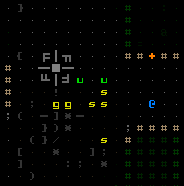
Firing through enemies. Eventually I just shoot right through them at the Fusion Modulator, which explodes.
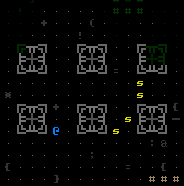
Firing through an Atomic Centrifuge at an incoming squad. I’m at an advantage since they won’t shoot their own machines.
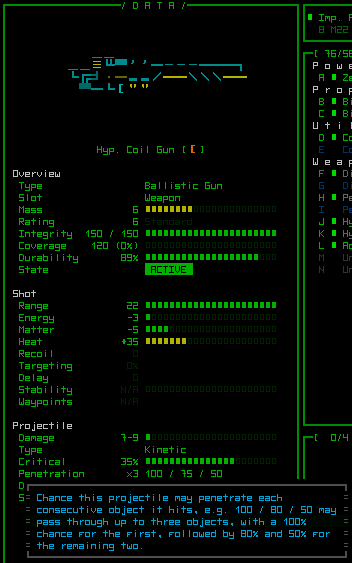
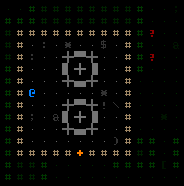


12 Comments
Oh this is fun stuff. I can definitely imagine building for sensors and penetration and having a whale of a time sniping stuff before it even knows you’re there.
I like the tactical implications of the bots not firing at their own hardware. Is that the case with all AIs though? It might get a little cheap if it worked against all of them, and it seems like it’d be more interesting if, say, they responded to your increasing threat potential by sending in stuff that just blows up the whole goddamn level to get you.
Also Hunters and Programmers were both a real fun surprise when they first jumped me in the prototype. Added a lot to tension from then on since I was always on alert for them. Can see that being even moreso now that hunters can surprise you from behind walls.
Definitely lots of fun! (in my short playtests) A sensors + hypervelocity build should be pretty cool, though you’ll have to find the right layout that will give you enough shots to pull off kills (or at least disarmament) before the enemy gets to you. Better types of sensors will also be helpful to avoid wasting shots on all the non-hostiles going about their business.
Enemies not shooting through their own machines only buys you a few extra turns, as they almost always attack in groups which will split up around obstacles to reach you. Plus your own attacks will pretty quickly fill a machine with holes meaning they’ll be able to return fire pretty quickly as soon as they have LOS. The blocking does not apply to all enemies, though, as Hunters will at least fire through their own machines to get you, as will possibly other enemy types if they have the right weapons. I’ll be working on AI soon and this is among the long list of issues to consider.
Hunters can blow through walls in the 7DRL, too, but there was no such thing as penetration then and their weapons are sometimes underpowered for the job (depending on the Hunter and depth), so they can end up just sitting there shooting at the wall until you show up. It’ll be real interesting when they can do a better job of shooting through walls. This should boost enemy tactics in that they’ll avoid getting drawn through doorways/bottlenecks too easily, since they can hit you from more angles. Of course this only applies to a subset of enemies who have weapons like this. Rarely will an enemy have a true hypervelocity weapon, though, because they are a bit too deadly for the player to face very often since they have such a high critical chance.
In the 7DRL Programmers were the main gameplay device to push the player forward in lieu of a food clock. Glad you liked them--they really are pretty fearsome and when I play my main worry is when they’ll show up next. That mechanic will be expanded with some even deadlier enemies this time around (later in the game, of course). There will also be another important new “food clock”-like element that I’ll be writing about in a future post. In fact, this element is almost exactly as you describe: As your threat increases the enemy sends in more powerful robots to get you, something you don’t have to worry about as much if you lay low and don’t raise hell. I’ll go into the details later on.
Guillaume Clemens over on Facebook had a good question that I think deserves to be copied here to expound on this post:
“More seriously, I know that it’s substantially more complicated to implement (or not ? who knows) but a more sensible, if not more realist way to do penetration would be to give a hardness coefficient to walls/ennemies/what not and use an energetic model for the weapon’s projectile in order to determine if it passes through or not.
You can even imagine that energy would be dissipated while the enemy is being perforated and deformed by the shot, thus dampening the projectile further and preventing more penetration, the possibilities are endless;
So, why did you settle for a basic counter based approach ? (Not a critic, I just want to know if you wanted to keep it simple or if it simply isn’t a feature critical enough to warrant such complexion)”
Response:
Good point to bring up. My intention was, as you mention at the end, purely to keep it easy to understand. It would not be difficult at all to implement the more detailed system you suggest, but its benefit would be lost on a game like Cogmind in which the terrain is generally very simple. There are pretty much just walls, doors, and machines (plus robots, since we’re talking about penetrable objects).
I do plan to implement material-based coefficients and projectile degredation when I get back to my other project, X@COM, because in that game there is a huge variety of specific real-world terrain and we’ll want penetration to be relatively realistic depending on what weapon you’re using and what you’re trying to shoot through. By comparison Cogmind is a lot less realistic and more gamey (which it can afford to be because it’s not modelling the real modern world).
First off: Penetration sounds like it’s going to be a heck of a lot of fun. :)
Second: Y’know, for obscure reasons, this post (specifically the ‘sensor + hypervelocity = wallhack’ trickery, which is awesome) bought something that has been bugging me a little to the forelight: As I understand it to date, weapon slots hold guns, generators give power, propulsion lets you move… and utilities let you do anything and everything else, correct? Everything from boosting your hacking, to seeing through walls, to carrying more stuff, to cooling off your guns, and even straight up keeping you alive (via aromour, but you get the idea).
Is this correct? If so, it suggests that Utilities is by far the most flexible slot to have; the one most able to adapt to varying conditions and equipment and foes. In a roguelike (and I’ve played a few), the ability to react to changing circumstance is one of the most crucial skills a charactr can have, which suggests that Utilities could end up the most valuable slots; with variations in the other slotcounts -- beyond ‘enough’, which will vary depending on whether you want to be fighty or sneaky, but only somewhat -- risk ending up being gimmick builds.
Have I missed something with regarding component flexibility here?
First off, glad you like the new penetration mechanic :)
About the slot types, you are absolutely correct in your observations regarding flexibility. I touched upon this topic briefly in this post (see the “Design” subsection), so check that out for some background, though I’ve never directly addressed the idea that there could be a “perfect strategy” for the whole system.
Utility slots are certainly the most flexible, and I do think that by the end game an ideal build will generally have more utility slots than others, and that there is a general “optimal” distribution to target while playing. BUT, there is still room for variability depending on strategy, and just as importantly the order in which slots are chosen. Usually what you have in your inventory at upgrade time, or even your experiences on a particular map level, will affect what you decide you need more of at that time.
Maybe you find a certain powerful weapon that requires a huge amount of energy to use--energy you won’t have without an extra power source (batteries would only last so long in a fight). Maybe you keep loosing propulsion units and getting bogged down in combat when you could’ve been long gone, so you need another one for the extra speed and to maintain speed when they start getting shot off. A lot of my own choices about upgrades tend to be reactive depending on what parts I’ve found, since in Cogmind it can be difficult to plan ahead as the situation changes quickly, and you find a lot of random gear.
I admit I nearly always wish I had room for more utilities, but there are other considerations, too. As versatile as they are, when all hell breaks loose two of the best options are 1) run away fast or 2) shoot the hell out of everyone, and utilities can do neither on their own.
Another benefit to having many weapons instead, one which won’t be apparent unless you’ve played a lot of the 7DRL or read the old manual, is the fact that the more weapons you fire at once, the less time it takes to shoot each one (this takes into consideration that much of the firing is simultaneous, and the only drawback in this situation comes if you are using high-recoil weapons which will throw off each others’ aim). This can put you at a disadvantage if you decide to fire an entire volley at a weak enemy separate from a group, but that’s a simple tactical error--fire at a group of enemies so that missed shots might hit another, and there’s a much higher chance of hitting/destroying cores in one volley than slowly trading shots back and forth. Most enemies only have one or two weapons so they cannot take advantage of simultaneous fire like you can. If you choose the right fights with a weapon-heavy build, you may not even need to take much damage at all.
I also sometimes like to have multiple sets of equipped weapons of various types, and only activate those that are most effective against the given target. If anything having an extra explosive weapon at the ready is a good idea. So there are certainly some good strategic reasons to seriously consider more weapon slots as well.
Power slots are definitely just a category that you “use the minimum you can get away with,” but I think the other three all have valid reasons/strategies for emphasis.
In this talk about utilities we’re also assuming that you have exactly the ones you want/need, which will not always be the case, more so considering they are the single largest category of items.
In summary, the question of what is “enough” of the other slots has no definite answer, but I agree in that my own preferred course for upgrading is to decide whether I can “get away with” the current number of other slot types, and if so go utility. Interestingly, almost no matter what you choose when evolving (upgrading), you’ll find that while playing the next depth you will at some point wish you had an extra of a different slot instead :)
For me that says something about the versatility of the system as a whole.
By the way, have you tried the 7DRL before? Is that how you played it? It will be very interesting to see future player statistics, including the best builds etc. The 7DRL had a lot of statistics, and the new version has a zillion more, so there will be a lot of fun data to parse and learn from!
Your point reminds me of the discussion I had with my brother before even the prototype, where we were arguing for different versions of the slot system. I originally believed it would best be done where any slot could be used for anything, and he was adamant that we needed categories. Obviously I eventually decided to go with slots, because it’s more fun (and easier to balance) with clearly identifiable categories, an unfortunate side effect being that all the miscellaneous parts end up thrown into a single category that covers what are in many cases completely unrelated items. Interesting trivia: The “weapons” category was in the first iteration (on paper) called “military” and included some of what are now utilities. (“Military” sounding stupid was a good enough reason to scrap that idea…)
Sheesh, you’ve gotten me to write an entire post in the comments section :)
So post it! :) And yes, I’d played the 7DRL and noticed a distinct tendancy towards ‘how few generators can I fit, and do I have enough propulsion for the moment? All good? OK, then do I want guns or utilities then’ as my default method of getting by.
Your last point touched on something I’d been mulling over whilst commuting to work -- why you’d chosen to have “This slot does this job” for everything except Utilities; it seemed to be the main ‘problem’ with said. An option (that I literally came up with while commuting to work, but hey it’s a boring trip :P) could be something more abstract, like “High (currently guns), Low (Prop), Central (Generation), and Internal (Utilities like hacking and aiming, etc), and then you’d have the option of allowing, eg, bins to fit into Central or High, while a scanner might go Internal or Central, and an armoured glacis might fit Central or Lower… you get the idea, I’m just throwing things out.
It might well be too late to change such a setup, but it did raise the interesting possibility of “My speedster is helpless on this level, so I’ll grab a bunch of armour and tank my way past those net-thrower turrets* instead” or the like; or a gunnery bot swapping out Central ammo bins for power generators when he stumbles apon the MegaLaser 9000…
And so I was curious a) whether you’d considered it, and b) if so, why you’d decided against it. Either way, it was an interesting thought while cruising the motorway! Guess I’ll have to buy this game now, if only on the basis that it entertained me when I’m not even playing it! :P
* Yes, I made those up. I know the original didn’t have such kit, but who knows! That’s rather the point of all this, isn’t it :)
I used to do all my best brainstorming while commuting. Now I no longer have that kind of down time and spend a lot less time just “thinking,” which is kinda unfortunate.
No, I did not consider the possibility you suggest--at the time I was really in a hurry to plan for the 7DRL :) And since the 7DRL seemed pretty fun, I didn’t mess with the core mechanics during the re-design. It would not be impossible to switch up the slot system at this point as it would only really require re-classifying all the items and changing up the interface a bit. (Surprising since it’s so central to the game, though I’m sure there are many other little things here and there to address.)
I really do like your idea as it sounds like a way to make everything a bit more versatile, sort of like a middle path between the extreme options my brother and I discussed. My fear with such a system would be its complexity. Right now given only an item name you can always easily tell what slot it would belong to and don’t have to otherwise know or worry about that as part of the decision. I suppose a well-designed UI could still convey the necessary information visually, though it could make designs a bit more “puzzle-like.”
Honestly your suggestion seems promising enough that I’d want to experiment with it. I’ll likely have to hold myself back from actual implementation simply due to time restrictions though--trying to press forward with essentials rather than get bogged down in endless feature creep.
However, continuing to discuss this idea as a possibility, let’s flesh it out as a thought experiment:
So we have High, Low, Central, and Internal. Weapons could be High (and probably Low too, yeah?), propulsion would be Low, power is always Central. So far each existing category pretty much has its own slot type.
The outlier is Utilities, of which processors/hackware belong to Internal but the remaining devices, storage, and armor sub-types can now be allocated in any number of places. Does this differ on a per-item basis? I believe that would be a bit too complex and messy, meaning we have to decide their restrictions on a per-category basis--devices can be Central/Internal, armor can be High/Low/Central (that’s a lot), and storage can be… ? (Central/Internal?)
I suppose some of this depends on the concepts behind the system. Are High/Low/Central all “external” slots as opposed to Internal? Hm, if so why isn’t power Internal? Perhaps “Central” is a bit less concrete in this regard--more of a “large central area” mostly behind High/Low front sections, but larger than what “Internal” refers to.
In summary, it seems like this system is for the most part allowing utilities to be split up a bit more so that you don’t tend to prefer a single slot type. I like the premise, though another drawback (besides the whole complexity issue) is that it makes your Cogmind / slot distribution a good bit more “amorphous.” As is you can look at a slot arrangement and have a very clear idea of the possibilities. With the alternative system it’s not so clear cut. I’m not saying the latter is necessarily a bad thing for everyone--some players would probably enjoy the complexity more, though I somewhat prefer the direct simplicity of A=>A, B=>B, C1/C2/C3/C4=>C, and D=>D, especially when there are already so many decisions to make in game. The alternative system seems to translate be something like D/C3=>A, B/C3=>B, A/C2/C3/C4=>C, C1/C2/C4=>D.
If you’re up for it I’d still like to hear more about how you’d design your version, especially if it’s significantly different from what I’ve proposed here in my expansion.
Ha, neat :)
I shall give it some thought! (As noted, it might take a few more commutes to really gel into place :P) I think you’ve cottoned on to the design pretty closely, so there shouldn’t be too much to quibble on, but as an initial sketch-out:
A good design would give only one or two ‘slots’ per item; to do more makes things amorphous and squishy. It might be suitable for some weird and/or unique things (Nanogoop, or something!), but you’d want to keep it consistent otherwise.
Weapons, Propulsion, Generation & Hacking always have only one spot option (barring weird uniques again -- a central mounted melee spike called the Unicorn might be legit, or the like) -- their current locales. This helps enforce the ‘definition’ of particular build, because they’ve got a single job at hand. High and Low are explicitly external stuff, Central is more muddied, and Internal is almost always the smaller chips and antennae and other bits in between.
As you note, the flexibility would be in the various Utilities -- bins and batteries would load into High and Central, because you’re either mounting them on the body of the vehicle or you’re hanging them on the gun hardpoints beside the guns they’re feeding; armour is central or propulsion (think how they put armoured skirts on a tank), while a targeting sensor might be internal, or bolted on the top of the hull for Central.
I think a useful way to split this out might be to make it consistent for each part -- bins are always high/central, Targeting Lasers are always Internal or Central, and the like. That way you do muddy the waters a little, but with familiarity people can work it out pretty quick anyway.
One aspect that could make this interesting is that shifting Generators to Central could make for new parts possibilities -- you have Heat Sinks, which would stay Internal, but now you can run Coolant Pumps, which actually cost power when running and are Central, or some such thing.
An important thing to be careful of is keeping the new Internal useful -- we don’t want it to go from being the Omnislot to being the Niche one! But that could as well come down to being thoughtful and/or somewhat aggressive in making sure that enough versatility fits into it that you want a bunch around for more than just Hacking chips. I’m sure it can be done!
And I’ll give more thought as time (and commutes) go by. I’m glad you find it an interesting thought. :)
So to break it down again, looks like you do pretty much mean to have everything the way it is now, only 1) rename the slots and 2) split up utilities so that they can use both their own fourth slot and some of the others, depending on their type. That can work mechanically and would result in better balance, though the cost in clarity is rather high for the benefits.
There are already cooling systems which require more power to operate, though they are devices that use utility slots. I guess as you describe them here they are just one example of “being able to put utilities into multiple slots and still make sense.”
About keeping the Internal slot useful, that’s definitely not a problem as Processors would most likely be focused there along with Hackware (the latter is just another name for the new types of Processor utilities related to hacking); many Devices would also belong in that category.
To get a better idea of what’s out there (if you don’t mind spoiling the game somewhat), you can open data/items.xt in the 7DRL and see a full list of items from the prototype. That will show you what kinds of parts fall under Utilities, and the full range of categories to consider. There are many item additions (including lots of new utilities), but the only category additions from the 7DRL are melee weapons and hackware utilities.
(Aaaand now that I’m back from a rather busy weekend) thanks for the tip -- I’ll give it a go!
“you can now even fire through walls to hit targets on the other side without taking down the wall itself”
What kind of feedback we’ll receive, to know if we’re been shot from behind some wall and from what side?
Excellent question. For now, specific feedback is you’ll hear it, you’ll maybe see the projectile coming through the wall if it’s far enough away (because hypervelocity projectiles move incredibly fast, so they can be difficult to see when fired at close range), and you’ll also often see debris flying from wherever the penetration occurs. The calculations log will also contain information indicating that a weapon was fired and you were hit (though it won’t show direction).
Yet even with all that different kinds feedback, it’s true that there is no way to retroactively know where an attack occurred, and I can imagine some situations in which it may not be entirely clear. Since Cogmind isn’t a real-time game and you’re generally watching the space around yourself while performing actions anyway, I think the current solutions are okay. If not, then we can change it later ;)
However, also know that very few enemies use penetrating weapons, so this isn’t something you’ll encounter often, anyway. The addition of hypervelocity weapons was mostly to give Cogmind himself another strategic option.